Writer Tips - Blog Posts
Useful Writing Resources
This is an extensive list of resources for every problem you could come across while writing/planning/editing your novel. Use it well;)
{ *** } Indicate a Highly Reccommended Resource

Planning/outlining Your Work
How To Outline ***
Zigzag Method : Creating Plots
How to Plot a Romance Novel
Seven Great Sources of Conflict for Romances
Let’s talk about brainstorming
Writing Something With Meaning ***
Past Or Present Tense? : How To Decide
Writing Your Work
How To Write A Fabulous Chapter #1 ***
How to Build a Romance Thread in Your Story
The Big Book Of Writing Sex ***
6 Ways to Get Your Readers Shipping Like Crazy
Romance Writing Tips ***
20 Tips for Writing Lovable Romance Novel Heroes
7 Ways To Speed Up Your Writing ***
80+ Barriers to Love: A List of Ideas to Keep Romantic Tension High
9 Romance Writing Mistakes to Avoid
Removing the Creeps From Romance
19 Ways to Write Better Dialogue ***
50 Things Your Characters Can Do WHILE They Talk ***
How To Write Action And Fight Scenes
10 Steps To Write Arguments
9 Ways To Write Body Language
Writing Good Kissing Scenes
Writing Murders
Create And Control Tone ***
Tips for Writing Ghost Stories
Incorporating Flashbacks
12 Tips To Avoid Overwriting ***
Characters
Behind the Name
Top Baby Names
Looking for a name that means a certain thing? ***
7 Rules of Picking Names
Most Common Surnames ***
Minor Character Development
Writing Antagonists, Antiheroes and Villains
Characters With Enhanced Senses
5 Tips to Help You Introduce Characters
How Do You Describe a Character?
How To Write Child Characters
36 Core Values For Building Character
Questions To Answer When Creating Characters ***
4 Ways to Make Readers Instantly Loathe Your Character Descriptions
5 Ways to Keep Characters Consistent
Character Archetypes
25 Ways To Fuck With Your Characters
Building Platonic Relationships Between Female Characters
9 Simple and Powerful Ways to Write Body Language
33 Ways To Write Stronger Characters
Conveying Character Emotion
How to Make Readers Love an Unlikable Character…
How to Create Powerful Character Combos
How To Describe A Character’s Voice ***
Describing Clothing And Appearance ***
Career Masterpost ***
Creating Your Character’s Personality ***
Character Flaws ***
Editing
DON’T EDIT>>> REWRITE THE WHOLE THING FIRST
Ultimate Guide To Editing Each Aspect Of Your Work ***
Why You Would Read Your Novel Out Loud ***
Grammar and Punctuation ***
How To Write A Captivating First Sentence
10 Things Your Opening Chapter Should Do: A Check-List for Self-Editing ***
Saving Your Story: Finding Where It Went Wrong
How To Condense Without Losing Anything
The Stages Of Editing
Dialogue/Description Balance
3 Proofreading Tips
The Short Story Form
Chapter & Novel Lengths
Anatomy Of A Novel : Chapters and Parts ***
How To Write Chapter After Chapter Until You Have A Book ***
Where Chapter #2 Should Start
Step By Step Guide To Editing Your Draft
Writing Tool: CTRL-F (How And Why You Should Use It) ***
How To Kill A Character
25 Steps To Edit The Unmerciful Suck Out Of Your Story
5 Ways To Make Your Novel Helplessly Addictive ***
Setting
{Setting} How To Describe Setting In Your Stories ***
20 Questions To Enhance Setting
How To Bring Your Setting To Life
Miscellaneous Resources You Can Use In Between
How to Write from a Guy’s POV
The Emotional Wounds Thesaurus
Text To Speech Reader
Compare Character Heights
A Visual Dictionary of Tops
Writers Helping Writers
7 Tricks To Imrove Your Writing Overnight
Work Out/ Word Count : Exercise Between Writing ***
Most Important Writing Tips ***
Let’s talk about diversity in novels
Letting Go Of Your Story
Keeping A Healthy Writing Schedule And Avoiding Procrastination ***
How To Create A Good Book Cover
Write or Die
Tip of my Tongue
Character Traits Form
Online Thesaurus
Writing Sketchy/Medical/Law
Coma: Types, Causes, etc
Tips for writing blood loss
Gunshot Wound Care
Examples of Hospital Forms
Common Legal Questions
The Writer’s Forensics Blog
Brain Injury Legal Guide
Types of Surgical Operations
Types of Mental Health Problems
A Day in the Life of a Mental Hospital Patient
Global Black Market Information ***
Crime Scene Science
Examining Mob Mentality
How Street Gangs Work
Writers’ Block Help/ Productivity
Story Plot Generator
@aveeragemusings ‘ Cure To Writers’ Block ***
50 Romance Plot Ideas
Reading Like A Writer ***
Defeat Writers’ Block
Writing In A Bad Mood ***
Writers Block
When You’ve Lost Motivation To Write A Novel ***
What To Do When The Words Won’t Flow ***
9 Ways To Be A More Productive Writer
“I Cannot Write A Good Sentence Today” (How To Get Over It) ***
Real Writing Advice ***
Info You Need To Know & Words You Didn’t Think Of
A Writer’s Thesaurus ***
Words To Describe… ***
Words & Phrases To Use In Your Sex Scenes ***
Colors (An Extensive List Of Colors)
List Of Kinks & Fetishes ***
List Of Elemental Abilities
inkarnate.com : World Creator And Map Maker For Your Imaginary Setting
Body Language Phrases
List Of Legendary Creatures
How To Write Magic
Hairstyle References
Hemingway : Writing Checker
Body Types: Words To Describe Bodies and How They Move Around
Poisonous Herbs and Plants ***
The Psychology of Color
The Meaning behind Rose color
Types of Swords
Color Symbolism
How a handgun works
How to Write a Eulogy
Types of Crying
Avoiding LGBTQ Stereotypes ***
Superstitions and More
The 12 Common Archetypes
Language of Flowers
12 Realistic Woman Body Shapes
Using Feedback And Reviews
Turning Negative Reviews Into Positive Ones ***
Proofreading Marks : Easy Symbols To Make Reviewing/Feedback Easier ***
Authonomy Teen Ink Figment Fiction Press ReviewFuse
These Are Trusted Critique Sites ;)
ATTENTION WRITERS
Google BetaBooks. Do it now. It’s the best damn thing EVER.

You just upload your manuscript, write out some questions for your beta readers to answer in each chapter, and invite readers to check out your book!
It’s SO easy!

You can even track your readers! It tells you when they last read, and what chapter they read!

Your beta readers can even highlight and react to the text!!!

There’s also this thing where you can search the website for available readers best suited for YOUR book!
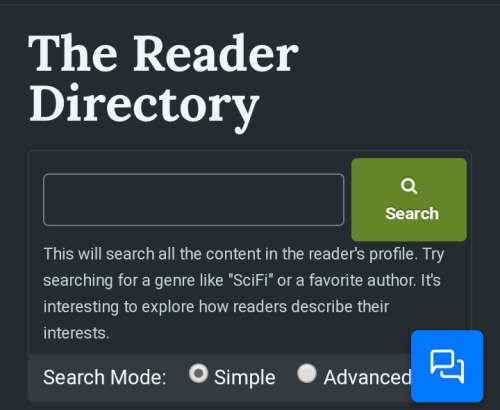
Seriously guys, BetaBooks is the most useful website in the whole world when it comes to beta reading, and… IT’S FREE.
Excellent tips and habits for writers
The advice I've given before is to write every scene you think of, no matter if it gets used or not. Its always a great idea to go back every once and a while and edit these scenes, or revise them.
Never force inspiration or a scene. If it isn't coming naturally, take a break and come back later or the next day. it's important to give yourself time to think. use your break to day dream about your story and what could come next. if your brain is happy, this should be relatively simple. If your brain isn't happy, then you need to take a longer break, stop writing for the day all together, or write something else.
if you're a pantser, like me, and it's hard to plot. You can practice reverse plotting, and plot your story as you go. make notes of things that happen in your story, changes in a character, changes in the plot, changes in the setting, dates for events, timelines, important information that's been revealed, anything you deem important to your story.
always reread what you've already written. don't try to edit it. turn off your editor brain and reread your story so far before you resume writing, so you can get into the voice and tone that you've already established.
if you're finding it difficult to start writing or keep writing. try turning off your internal editor and free write. it's good practice to be able to write down your unfiltered thoughts or daydreams without having to stop and edit while you're writing. it helps with your writing flow, getting the scene down onto the page, and increases your writing intuition.
before you write, always take time to daydream or think about your story beforehand. it helps things go much smoother in the long run.
if you've been working on something for a long time, don't pressure yourself into confinement. if you want to work on something new but you're worried about what you've been working on, don't. stop worrying and write what you want. forcing yourself to keep writing something when you don't want to is just going to make you burn out faster.
don't be afraid to create visuals or playlists that help you with what you're writing. It's an enviable talent to be able to write something off a photo you saw on pinterest, or a song you really like.
if you find yourself in a mood where you want to write really badly, but you have no idea what you want to write, and none of the prompts you find are appealing enough. find an activity you use to destress, whether its listening to music, listening to asmr, doom scrolling on social media, or browsing pinterest. go do that. chances are, you'll find something that will inspire you what to write when you're not looking for it.
FAQ Masterpost:
WRITING TIPS:
How To Stay Positive
Write Stories That Are Problematic
On Being Distracted By Your Phone
How To Write a Synopsis
Quick and Easy Writing Tip for Social Media
8 Tips to Get You Through NaNoWriMo
Top Ten First Page Turn Offs
How to Limit Hand Stress (EDS oriented)
How to Write Dragons
How to Write ESL
How to Choose a Story Idea
“Help! How do I connect a plot hole?”
How to Stick to a Writing Schedule (and Keep It)
The Importance of Exposition
8 Ways to Get Past Writer’s Block
^^^ Video Version
Writing a Sword Fight Scene
Why You Should Write Horribly
Finding Your Audience
5 Ways to Write Solid Description
How to Make Your Readers Cry
Scrivener PSA - a Great Writing Software
Creating a Language
CHARACTER TIPS:
How To Write Characters Outside of Your Identity
5 Ways to Develop a Convincing Character
How to Write Strong Dialogue
POV Writing Exercise
How Do Characters Bond?
How to Choose Your MC’s Personality
Writing a Mute Character
How to Write a Bisexual Character
How to Avoid Insta-Love
Writing Gray Characters
How to Write Believable Romance
EDITING TIPS:
Stuck? Do this
How to Use -, –, and —
How to Read Like a Writer
For Writers Who Edit When They Should Be Writing
Getting an Editor - Yes or No?
How to Up Your Editing Game
NETWORKING:
How to Find Beta Readers
On Paying Beta Readers
How To Find a Critique Partner
What To Expect From A Critique Partner
When Considering Feedback
How to Enter Into Contests/Magazines
How to Write a Query/Cover Letter
Marketing Tips
How to Make Connections
WRITING INSPIRATION:
How to Find Inspiration to Write
If You Write Fanfic, Are You a Writer?
If You Need Someone to Tell You to Write
How to Stop Being a Beginning Writer
Stop Feeling Bad
Read Your Old Work Like This
To the Writers Who Don’t Write
On Cliches
The Steps of Writing
Why You Should Keep Writing Anyways
Do YOU Deserve Support?
Feeling Anxious About Writing?
Reminder About Writer’s Block
Need a Pep Talk?
WRITING FUNNIES:
America’s Next Top Writer
The Five Types of Writers
Need a lol? Have a meme
And another. Because commas are terrible
On writing fight scenes
On plot twists
On story ideas
On writer’s block
Writers: What They Say vs What They Mean
How to Kick Start a Writing Session
Writing and Friendship and Sacrifice
Fun Fact
15 Things That Make Writer’s Anxious
First Drafts Suck
Funny with a twist (also my most popular post ever)
Search “writing humor” on my blog for a ridiculous amount more
FIRST SENTENCE FRIDAY (FSF):
On My Opinion
Submitting BEFORE/AFTER Friday?
How to Write a Good Sentence
CLOVER RAINE AND THE BLACK DRAGON:

Synopsis
Prologue
Chapter One
Mood Board
World Building
Excerpt
Comic
MORE CONTENT:

WEBSITE
YOUTUBE
If you find my blog helpful, please consider throwing a tip my way :)
💜 Kira
C&D Original Book Update #1
Things are going great! I had this big problem with how I was going to introduce the letter exchange system between my protagonists because it was messy, with all these section breaks that I hear don't work well in kindle, too much repetition (like their addresses), it just didn't read right. Now it does...
Here's how I did it:
Transcript of the letters between:
—(Character's Name). (Address)
—(Character's Name). (Address)
(I put this at the beginning of the chapter)
Then before each letter, in bold:
(Character's Name)—
Voilá!
And at the first few letters I make clear who the character's writing.
This is the best system I've found... I researched all over the internet and no other system worked for my story.
Now, reading the chapters months after writing them, I've also cringed hard over some stuff, but oh well, I have enough time until September to fix them up. <3
please... if you’re going to attempt to speak in “old” english
THOU is the subject (Thou art…) THEE is the object (I look at thee) THY is for words beginning in a consonant (Thy dog) THINE is for words beginning in a vowel (Thine eyes)
this has been a psa

How to avoid character inconsistency in your writing
Set your character boundaries:
What's the background?
What's your character's backstory?
What are their traits, and how do they portray them?
Know what keeps your characters motivated. (Are they reaching their goal?)
You can avoid quick shifting of scenes. Let your readers absorb the setting of the scene.
Ensure that their actions and decisions align with their development and growth.
Tip 1: Start your chapter with a scene or dialogue that comes back at the end, which helps maintain consistency.
Tip 2: Throughout the chapter avoid the fast pacing of the story, rather let the characters express themselves so that it's clear for the readers.
Consider how your characters react to situations that are hard to convey. (Do they feel nervous? Scared? Fearless?)
Dialogue writing is crucial in explaining your character's personality while writing a story.
This process requires lots of re-reading and writing, fixing character holes and rewriting character arcs.
Writing pornographic short fic: moderately difficult; kind of mechanical in a fun way.
Ending pornographic short fic: HOW
If you’re having writers block…READ!!!! CONSUME MEDIA
I feel like I don’t hear that given enough as advice for writers block..just read? Watch tv? Movies? Find inspiration in media.
Writers block is a lack of inspiration, so go collect more.
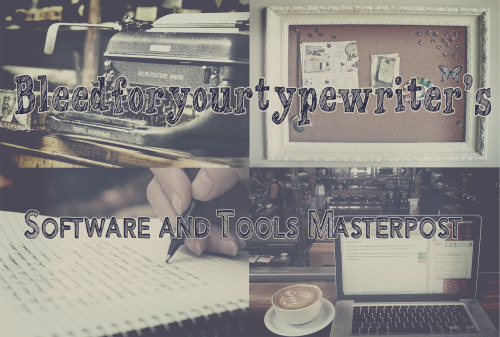
Ok here is a compilation of all the software and useful tools I’ve come across whilst writing. Some of them I’ve reviewed on here already, more coming soon.
Got an idea? Well get planning! Here’s some useful outlining, brainstorming and mind- mapping software:
Coggle
Lucidchart
Mural.ly
Blumind
MindMeister
Mindmaple
Mindomo
NovaMind
Popplet
Scapple
Tree Sheets
Visual Understanding Environment (VUE)
XMind
FreeMind
Oak Outliner
Work Flowy
The Outliner of Giants
Just want to get writing? You want a word processor:
Gedit
Google Docs
Kate
LibreOffice
Microsoft Word
My Writing Spot
NoteTab
Open Office
Quabel
Ted
Vim
yEdit
Making notes? Here you go:
CintaNotes
Evernote
KeepNote
Memonic
MS OneNote
Scribe
SuperNotecard
Tomboy
Timelines giving you a headache? Try these:
Aeon Timeline
Dipity
Preceden
Tiki-Toki
Timeglider
Timeline
TimelineJS
TimeToast
Now perhaps you want to organise those notes. Got a lot of research? Character sheets? Images? Well here’s some tools to keep all that together:
Liquid Story Binder XE
LitLift
PangurPad
Scriptito
Scrivener
Writer’s Café
Yarny
yWriter
Are you easily distracted? The following tools will keep you on track:
Dark Room
FocusWriter
JDarkRoom
Momentum Writer
OmmWriter
Q10
Writemonkey
Zen Writer
Even more productivity tools to help keep you focussed on your task:
Cold Turkey
FocalFilter
Freedom
InternetOff
Keepmeout
Nanny
Productivity Owl
RescueTime
SelfControl
SelfRestraint
Simple Blocker
StayFocusd
Strict Workflow
Time Doctor
Waste No Time
Website Blocker
So you’ve got something down? Need to edit?
AutoCrit
EditMinion
Grammarly
LyX
SlickWrite
SmartEdit
After the Deadline
All done? Perhaps you’d like some e-publishing tools:
Acrobat
InDesign
Calibre
CutePDF
Jutoh
Mobipocket Creator
PagePlus
PageStream
PDFCreator
Scribus
Sigil
Turns out I’d forgotten about screenwriters, so here goes:
CeltX
Plotbot
Scripped
ScriptBuddy
Trelby
WriterDuet
Slugline
Page2Stage
Highland
I’m feeling generous, have some more cool stuff:
750 Words
One Page per Day
Oneword
Penzu
Write or Die
Written Kitten
Focus Booster
Spaaze
AutoREALM (Map building software)
ETA: After a request I’ve added screenplay software to the list.
Words for Skin Tone | How to Describe Skin Color
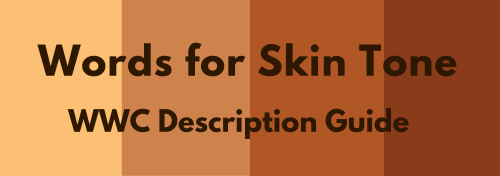
We discussed the issues describing People of Color by means of food in Part I of this guide, which brought rise to even more questions, mostly along the lines of “So, if food’s not an option, what can I use?” Well, I was just getting to that!
This final portion focuses on describing skin tone, with photo and passage examples provided throughout. I hope to cover everything from the use of straight-forward description to the more creatively-inclined, keeping in mind the questions we’ve received on this topic.
Standard Description
Basic Colors

Pictured above: Black, Brown, Beige, White, Pink.
“She had brown skin.”
This is a perfectly fine description that, while not providing the most detail, works well and will never become cliché.
Describing characters’ skin as simply brown or beige works on its own, though it’s not particularly telling just from the range in brown alone.
Complex Colors
These are more rarely used words that actually “mean” their color. Some of these have multiple meanings, so you’ll want to look into those to determine what other associations a word might have.

Pictured above: Umber, Sepia, Ochre, Russet, Terra-cotta, Gold, Tawny, Taupe, Khaki, Fawn.
Complex colors work well alone, though often pair well with a basic color in regards to narrowing down shade/tone.
For example: Golden brown, russet brown, tawny beige…
As some of these are on the “rare” side, sliding in a definition of the word within the sentence itself may help readers who are unfamiliar with the term visualize the color without seeking a dictionary.
“He was tall and slim, his skin a russet, reddish-brown.”
Comparisons to familiar colors or visuals are also helpful:
“His skin was an ochre color, much like the mellow-brown light that bathed the forest.”
Modifiers
Modifiers, often adjectives, make partial changes to a word.The following words are descriptors in reference to skin tone.
Dark - Deep - Rich - Cool
Warm - Medium - Tan
Fair - Light - Pale
Rich Black, Dark brown, Warm beige, Pale pink…
If you’re looking to get more specific than “brown,” modifiers narrow down shade further.
Keep in mind that these modifiers are not exactly colors.
As an already brown-skinned person, I get tan from a lot of sun and resultingly become a darker, deeper brown. I turn a pale, more yellow-brown in the winter.
While best used in combination with a color, I suppose words like “tan” “fair” and “light” do work alone; just note that tan is less likely to be taken for “naturally tan” and much more likely a tanned White person.
Calling someone “dark” as description on its own is offensive to some and also ambiguous. (See: Describing Skin as Dark)
Undertones
Undertones are the colors beneath the skin, seeing as skin isn’t just one even color but has more subdued tones within the dominating palette.
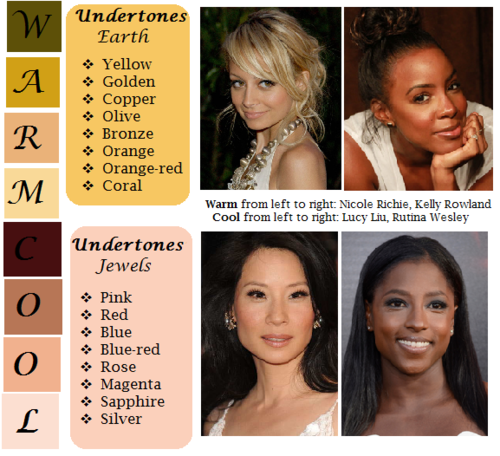
pictured above: warm / earth undertones: yellow, golden, copper, olive, bronze, orange, orange-red, coral | cool / jewel undertones: pink, red, blue, blue-red, rose, magenta, sapphire, silver.
Mentioning the undertones within a character’s skin is an even more precise way to denote skin tone.
As shown, there’s a difference between say, brown skin with warm orange-red undertones (Kelly Rowland) and brown skin with cool, jewel undertones (Rutina Wesley).
“A dazzling smile revealed the bronze glow at her cheeks.”
“He always looked as if he’d ran a mile, a constant tinge of pink under his tawny skin.”
Standard Description Passage
“Farah’s skin, always fawn, had burned and freckled under the summer’s sun. Even at the cusp of autumn, an uneven tan clung to her skin like burrs. So unlike the smooth, red-brown ochre of her mother, which the sun had richened to a blessing.”
-From my story “Where Summer Ends” featured in Strange Little Girls
Here the state of skin also gives insight on character.
Note my use of “fawn” in regards to multiple meaning and association. While fawn is a color, it’s also a small, timid deer, which describes this very traumatized character of mine perfectly.
Though I use standard descriptions of skin tone more in my writing, at the same time I’m no stranger to creative descriptions, and do enjoy the occasional artsy detail of a character.
Creative Description
Whether compared to night-cast rivers or day’s first light…I actually enjoy seeing Characters of Colors dressed in artful detail.
I’ve read loads of descriptions in my day of white characters and their “smooth rose-tinged ivory skin”, while the PoC, if there, are reduced to something from a candy bowl or a Starbucks drink, so to actually read of PoC described in lavish detail can be somewhat of a treat.
Still, be mindful when you get creative with your character descriptions. Too many frills can become purple-prose-like, so do what feels right for your writing when and where. Not every character or scene warrants a creative description, either. Especially if they’re not even a secondary character.
Using a combination of color descriptions from standard to creative is probably a better method than straight creative. But again, do what’s good for your tale.
Natural Settings - Sky

Pictured above: Harvest Moon -Twilight, Fall/Autumn Leaves, Clay, Desert/Sahara, Sunlight - Sunrise - Sunset - Afterglow - Dawn- Day- Daybreak, Field - Prairie - Wheat, Mountain/Cliff, Beach/Sand/Straw/Hay.
Now before you run off to compare your heroine’s skin to the harvest moon or a cliff side, think about the associations to your words.
When I think cliff, I think of jagged, perilous, rough. I hear sand and picture grainy, yet smooth. Calm. mellow.
So consider your character and what you see fit to compare them to.
Also consider whose perspective you’re describing them from. Someone describing a person they revere or admire may have a more pleasant, loftier description than someone who can’t stand the person.
“Her face was like the fire-gold glow of dawn, lifting my gaze, drawing me in.”
“She had a sandy complexion, smooth and tawny.”
Even creative descriptions tend to draw help from your standard words.
Flowers
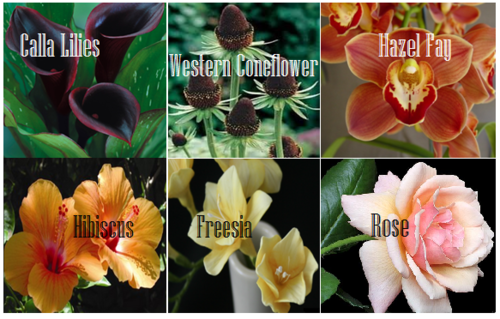
Pictured above: Calla lilies, Western Coneflower, Hazel Fay, Hibiscus, Freesia, Rose
It was a bit difficult to find flowers to my liking that didn’t have a 20 character name or wasn’t called something like “chocolate silk” so these are the finalists.
You’ll definitely want to avoid purple-prose here.
Also be aware of flowers that most might’ve never heard of. Roses are easy, as most know the look and coloring(s) of this plant. But Western coneflowers? Calla lilies? Maybe not so much.
“He entered the cottage in a huff, cheeks a blushing brown like the flowers Nana planted right under my window. Hazel Fay she called them, was it?”
Assorted Plants & Nature

Pictured above: Cattails, Seashell, Driftwood, Pinecone, Acorn, Amber
These ones are kinda odd. Perhaps because I’ve never seen these in comparison to skin tone, With the exception of amber.
At least they’re common enough that most may have an idea what you’re talking about at the mention of “pinecone."
I suggest reading out your sentences aloud to get a better feel of how it’ll sounds.
"Auburn hair swept past pointed ears, set around a face like an acorn both in shape and shade.”
I pictured some tree-dwelling being or person from a fantasy world in this example, which makes the comparison more appropriate.
I don’t suggest using a comparison just “cuz you can” but actually being thoughtful about what you’re comparing your character to and how it applies to your character and/or setting.
Wood

Pictured above: Mahogany, Walnut, Chestnut, Golden Oak, Ash
Wood can be an iffy description for skin tone. Not only due to several of them having “foody” terminology within their names, but again, associations.
Some people would prefer not to compare/be compared to wood at all, so get opinions, try it aloud, and make sure it’s appropriate to the character if you do use it.
“The old warlock’s skin was a deep shade of mahogany, his stare serious and firm as it held mine.”
Metals

Pictured above: Platinum, Copper, Brass, Gold, Bronze
Copper skin, brass-colored skin, golden skin…
I’ve even heard variations of these used before by comparison to an object of the same properties/coloring, such as penny for copper.
These also work well with modifiers.
“The dress of fine white silks popped against the deep bronze of her skin.”
Gemstones - Minerals
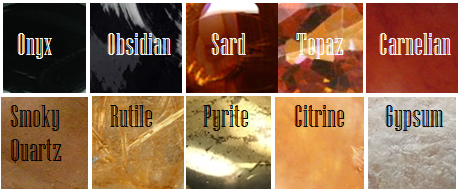
Pictured above: Onyx, Obsidian, Sard, Topaz, Carnelian, Smoky Quartz, Rutile, Pyrite, Citrine, Gypsum
These are trickier to use. As with some complex colors, the writer will have to get us to understand what most of these look like.
If you use these, or any more rare description, consider if it actually “fits” the book or scene.
Even if you’re able to get us to picture what “rutile” looks like, why are you using this description as opposed to something else? Have that answer for yourself.
“His skin reminded her of the topaz ring her father wore at his finger, a gleaming stone of brown, mellow facades.”
Physical Description
Physical character description can be more than skin tone.
Show us hair, eyes, noses, mouth, hands…body posture, body shape, skin texture… though not necessarily all of those nor at once.
Describing features also helps indicate race, especially if your character has some traits common within the race they are, such as afro hair to a Black character.
How comprehensive you decide to get is up to you. I wouldn’t overdo it and get specific to every mole and birthmark. Noting defining characteristics is good, though, like slightly spaced front teeth, curls that stay flopping in their face, hands freckled with sunspots…
General Tips
Indicate Race Early: I suggest indicators of race be made at the earliest convenience within the writing, with more hints threaded throughout here and there.
Get Creative On Your Own: Obviously, I couldn’t cover every proper color or comparison in which has been “approved” to use for your characters’ skin color, so it’s up to you to use discretion when seeking other ways and shades to describe skin tone.
Skin Color May Not Be Enough: Describing skin tone isn’t always enough to indicate someone’s ethnicity. As timeless cases with readers equating brown to “dark white” or something, more indicators of race may be needed.
Describe White characters and PoC Alike: You should describe the race and/or skin tone of your white characters just as you do your Characters of Color. If you don’t, you risk implying that White is the default human being and PoC are the “Other”).
PSA: Don’t use “Colored.” Based on some asks we’ve received using this word, I’d like to say that unless you or your character is a racist grandmama from the 1960s, do not call People of Color “colored” please.
Not Sure Where to Start? You really can’t go wrong using basic colors for your skin descriptions. It’s actually what many people prefer and works best for most writing. Personally, I tend to describe my characters using a combo of basic colors + modifiers, with mentions of undertones at times. I do like to veer into more creative descriptions on occasion.
Want some alternatives to “skin” or “skin color”? Try: Appearance, blend, blush, cast, coloring, complexion, flush, glow, hue, overtone, palette, pigmentation, rinse, shade, sheen, spectrum, tinge, tint, tone, undertone, value, wash.
Skin Tone Resources
List of Color Names
The Color Thesaurus
Skin Undertone & Color Matching
Tips and Words on Describing Skin
Photos: Undertones Described (Modifiers included)
Online Thesaurus (try colors, such as “red” & “brown”)
Don’t Call me Pastries: Creative Skin Tones w/ pics I
Writing & Description Guides
WWC Featured Description Posts
WWC Guide: Words to Describe Hair
Writing with Color: Description & Skin Color Tags
7 Offensive Mistakes Well-intentioned Writers Make
I tried to be as comprehensive as possible with this guide, but if you have a question regarding describing skin color that hasn’t been answered within part I or II of this guide, or have more questions after reading this post, feel free to ask!
~ Mod Colette

Discipline is far more important than how much time you have to write. You can’t just quit your job or stop going to school to make more time, but you can learn to make more out of the time that you already have.
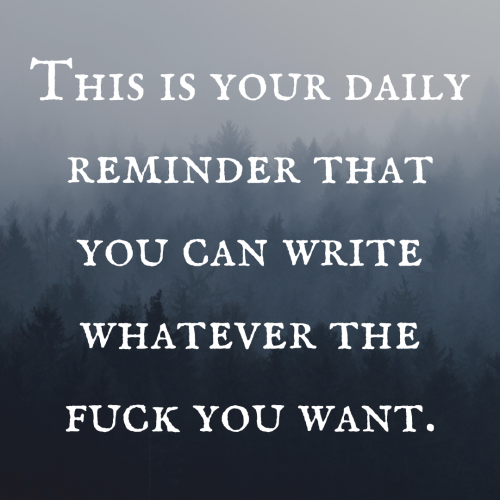
From my private meme collection. Since I also work as an editor I often have to remind myself there aren’t actually any rules in writing. I’m happiest when I let myself follow my obsessions, my interests, my fancies and caprices–even if that means it doesn’t “make sense,” or the results are weird, or I never finish it, or no one ever wants to read it or publish it, or it’s 5 words long, or it’s written on toilet paper, or whatever. Sharing for whoever needs to hear this today <3
If you’re having writers block…READ!!!! CONSUME MEDIA
I feel like I don’t hear that given enough as advice for writers block..just read? Watch tv? Movies? Find inspiration in media.
Writers block is a lack of inspiration, so go collect more.
WEBSITES FOR WRITERS {masterpost}
E.A. Deverell - FREE worksheets (characters, world building, narrator, etc.) and paid courses;
Rach Academia - FREEBIES (workbook, notion template, games, challenges, etc.);
Hiveword - Helps to research any topic to write about (has other resources, too);
BetaBooks - Share your draft with your beta reader (can be more than one), and see where they stopped reading, their comments, etc.;
Charlotte Dillon - Research links;
Writing realistic injuries - The title is pretty self-explanatory: while writing about an injury, take a look at this useful website;
One Stop for Writers - You guys... this website has literally everything we need: a) Description thesaurus collection, b) Character builder, c) Story maps, d) Scene maps & timelines, e) World building surveys, f) Worksheets, f) Tutorials, and much more! Although it has a paid plan ($90/year | $50/6 months | $9/month), you can still get a 2-week FREE trial;
One Stop for Writers Roadmap - It has many tips for you, divided into three different topics: a) How to plan a story, b) How to write a story, c) How to revise a story. The best thing about this? It's FREE!
Story Structure Database - The Story Structure Database is an archive of books and movies, recording all their major plot points;
National Centre for Writing - FREE worksheets and writing courses. Has also paid courses;
Penguin Random House - Has some writing contests and great opportunities;
Crime Reads - Get inspired before writing a crime scene;
The Creative Academy for Writers - "Writers helping writers along every step of the path to publication." It's FREE and has ZOOM writing rooms;
Reedsy - "A trusted place to learn how to successfully publish your book" It has many tips, and tools (generators), contests, prompts lists, etc. FREE;
QueryTracker - Find agents for your books (personally, I've never used this before, but I thought I should feature it here);
Pacemaker - Track your goals (example: Write 50K words - then, everytime you write, you track the number of the words, and it will make a graphic for you with your progress). It's FREE but has a paid plan;
Save the Cat! - The blog of the most known storytelling method. You can find posts, sheets, a software (student discount - 70%), and other things;
I hope this is helpful for you!
Also, don't forget to check my gumroad shop, where you can find plenty of FREEBIES (from notion templates for writers to workbooks and sheets).
-> Check out my freebies
Happy writing! <3
Alright.
Instead of whispered, consider:
murmured
mumbled
muttered
breathed
sighed
hissed
mouthed
uttered
intoned
susurrated
purred
said in an undertone
gasped
hinted
said low
said into someone’s ear
said softly
said under one’s breath
said in hushed tones
insinuated
WEBSITES FOR WRITERS {masterpost}
E.A. Deverell - FREE worksheets (characters, world building, narrator, etc.) and paid courses;
NotionByRach - FREEBIES (workbook, notion template, games, challenges, etc.);
Hiveword - Helps to research any topic to write about (has other resources, too);
BetaBooks - Share your draft with your beta reader (can be more than one), and see where they stopped reading, their comments, etc.;
Charlotte Dillon - Research links;
Writing realistic injuries - The title is pretty self-explanatory: while writing about an injury, take a look at this useful website;
One Stop for Writers - You guys... this website has literally everything we need: a) Description thesaurus collection, b) Character builder, c) Story maps, d) Scene maps & timelines, e) World building surveys, f) Worksheets, f) Tutorials, and much more! Although it has a paid plan ($90/year | $50/6 months | $9/month), you can still get a 2-week FREE trial;
One Stop for Writers Roadmap - It has many tips for you, divided into three different topics: a) How to plan a story, b) How to write a story, c) How to revise a story. The best thing about this? It's FREE!
Story Structure Database - The Story Structure Database is an archive of books and movies, recording all their major plot points;
National Centre for Writing - FREE worksheets and writing courses. Has also paid courses;
Penguin Random House - Has some writing contests and great opportunities;
Crime Reads - Get inspired before writing a crime scene;
The Creative Academy for Writers - "Writers helping writers along every step of the path to publication." It's FREE and has ZOOM writing rooms;
Reedsy - "A trusted place to learn how to successfully publish your book" It has many tips, and tools (generators), contests, prompts lists, etc. FREE;
QueryTracker - Find agents for your books (personally, I've never used this before, but I thought I should feature it here);
Pacemaker - Track your goals (example: Write 50K words - then, everytime you write, you track the number of the words, and it will make a graphic for you with your progress). It's FREE but has a paid plan;
Save the Cat! - The blog of the most known storytelling method. You can find posts, sheets, a software (student discount - 70%), and other things;
I hope this is helpful for you!
☕️ buy me a coffee! ☕️
my favorite free tools for writers
hello, hello! hope you're doing well.
today i am bringing you another list with my top 3 favorite (free!) tools that I find helpful for each phase of writing a novel.
brainstorming phase
Fantasy Names Generator - not only for fantasy (you can also generate real names). this website is just... amazing! it helps you come up with names for characters, places and locations, descriptions, generate traits, outfits (yes, outfits!!), and probably something else you could ever think of.
The Story's Hack - this one is so cool! you can generate names for everything, create your own generator, and practice writing through writing exercises! plus, you can save your generated names to see later, and you earn coins for each idea generated (you can later buy themes - dark, snow, forest, etc)
RanGen - my last favorite generator on this list is RanGen! you can generate plots, appearances, archetypes, love interests, cities, worlds, items, and more.
developing the idea phase
Bryn Donovan - in this blog you can find master lists under the tag "master lists for writers". it is so helpful when you first start developing the characters and need to find the right words to describe them and to find some quirks and flaws!
Writers Write (350 character traits) - again, this is so helpful!
Story Planner - ah, the number of times I've talked about this website... please, PLEASE take a look at it, you won't regret it. this website has literally everything you need to fully develop your idea with outlines for you to fill in step by step.
writing phase
Colleen Houck (80+ barriers to love) - need more romace conflict? there you go!
Cheat Sheets for Writing Body Language - so, you know how your character's feeling, but don't know how he'd physically act? check out this list!
Describing Words - honestly, this is a lifesaver. don't you struggle to find the right word to describe something? well, with this website all you have to do is to type the object you're trying to describe and see which description fits better to you!
revising phase
Language Tool for Google Docs - i know we all have heard about google docs before, but the truth is, it's almost impossible to find free softwares to check grammar and spelling. so, google docs is useful, because it automatically revises it for us, and it's completely free. plus, you can add adds-on, such as "language tool".
Unfortunately, there's only one (free) tool that I actually enjoy for the revising phase. if you know some others, please let me know so that I can try them out and feature in this list.
exporting phase
Google Docs - i find google docs very easy to format and export to .epub, so i'd recommend using it as a free tool.
Reedsy - this is also a free tool available online. all you have to do is to write down each chapter (copy and paste) or import your word document. it will format the document to your liking and export it to pdf, epub and mobi.
that's everything for now! i hope this post was somehow helpful or inspiring!
if you want to see more master lists full of resources, check these:
WEBSITES FOR WRITERS {masterpost}
BEST accounts to follow as a writer
BEST SITES & SOFTWARES TO WRITE FICTION
DIALOGUE IDEAS TO GET RID OF THAT WRITING BLOCK (masterpost)
Useful Resources & Tips for Writers
also, if you are a notion lover just like me, check the free template I just released with everything you need to develop and write your novel!
thank you so much for reading! hope to see you around, and have a nice day <3
WEBSITES FOR WRITERS {masterpost}
E.A. Deverell - FREE worksheets (characters, world building, narrator, etc.) and paid courses;
Hiveword - Helps to research any topic to write about (has other resources, too);
BetaBooks - Share your draft with your beta reader (can be more than one), and see where they stopped reading, their comments, etc.;
Charlotte Dillon - Research links;
Writing realistic injuries - The title is pretty self-explanatory: while writing about an injury, take a look at this useful website;
One Stop for Writers - You guys... this website has literally everything we need: a) Description thesaurus collection, b) Character builder, c) Story maps, d) Scene maps & timelines, e) World building surveys, f) Worksheets, f) Tutorials, and much more! Although it has a paid plan ($90/year | $50/6 months | $9/month), you can still get a 2-week FREE trial;
One Stop for Writers Roadmap - It has many tips for you, divided into three different topics: a) How to plan a story, b) How to write a story, c) How to revise a story. The best thing about this? It's FREE!
Story Structure Database - The Story Structure Database is an archive of books and movies, recording all their major plot points;
National Centre for Writing - FREE worksheets and writing courses. Has also paid courses;
Penguin Random House - Has some writing contests and great opportunities;
Crime Reads - Get inspired before writing a crime scene;
The Creative Academy for Writers - "Writers helping writers along every step of the path to publication." It's FREE and has ZOOM writing rooms;
Reedsy - "A trusted place to learn how to successfully publish your book" It has many tips, and tools (generators), contests, prompts lists, etc. FREE;
QueryTracker - Find agents for your books (personally, I've never used this before, but I thought I should feature it here);
Pacemaker - Track your goals (example: Write 50K words - then, everytime you write, you track the number of the words, and it will make a graphic for you with your progress). It's FREE but has a paid plan;
Save the Cat! - The blog of the most known storytelling method. You can find posts, sheets, a software (student discount - 70%), and other things;
I hope this is helpful for you!
(Also, check my blog if you want to!)

